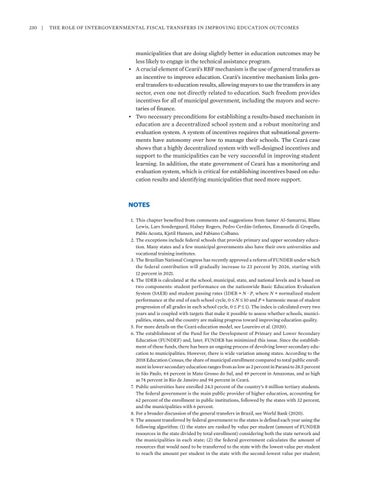230 | The Role of Intergovernmental Fiscal Transfers in Improving Education Outcomes
municipalities that are doing slightly better in education outcomes may be less likely to engage in the technical assistance program. • A crucial element of Ceará’s RBF mechanism is the use of general transfers as an incentive to improve education. Ceará’s incentive mechanism links general transfers to education results, allowing mayors to use the transfers in any sector, even one not directly related to education. Such freedom provides incentives for all of municipal government, including the mayors and secretaries of finance. • Two necessary preconditions for establishing a results-based mechanism in education are a decentralized school system and a robust monitoring and evaluation system. A system of incentives requires that subnational governments have autonomy over how to manage their schools. The Ceará case shows that a highly decentralized system with well-designed incentives and support to the municipalities can be very successful in improving student learning. In addition, the state government of Ceará has a monitoring and evaluation system, which is critical for establishing incentives based on education results and identifying municipalities that need more support.
NOTES 1. This chapter benefited from comments and suggestions from Samer Al-Samarrai, Blane Lewis, Lars Sondergaard, Halsey Rogers, Pedro Cerdán-Infantes, Emanuela di Gropello, Pablo Acosta, Kjetil Hansen, and Fabiano Colbano. 2. The exceptions include federal schools that provide primary and upper secondary education. Many states and a few municipal governments also have their own universities and vocational training institutes. 3. The Brazilian National Congress has recently approved a reform of FUNDEB under which the federal contribution will gradually increase to 23 percent by 2026, starting with 12 percent in 2021. 4. The IDEB is calculated at the school, municipal, state, and national levels and is based on two components: student performance on the nationwide Basic Education Evaluation System (SAEB) and student passing rates (IDEB = N ∙ P, where N = normalized student performance at the end of each school cycle, 0 ≤ N ≤ 10 and P = harmonic mean of student progression of all grades in each school cycle, 0 ≤ P ≤ 1). The index is calculated every two years and is coupled with targets that make it possible to assess whether schools, municipalities, states, and the country are making progress toward improving education quality. 5. For more details on the Ceará education model, see Loureiro et al. (2020). 6. The establishment of the Fund for the Development of Primary and Lower Secondary Education (FUNDEF) and, later, FUNDEB has minimized this issue. Since the establishment of these funds, there has been an ongoing process of devolving lower secondary education to municipalities. However, there is wide variation among states. According to the 2018 Education Census, the share of municipal enrollment compared to total public enrollment in lower secondary education ranges from as low as 2 percent in Paraná to 28.5 percent in São Paulo, 44 percent in Mato Grosso do Sul, and 49 percent in Amazonas, and as high as 74 percent in Rio de Janeiro and 94 percent in Ceará. 7. Public universities have enrolled 24.3 percent of the country’s 8 million tertiary students. The federal government is the main public provider of higher education, accounting for 62 percent of the enrollment in public institutions, followed by the states with 32 percent, and the municipalities with 6 percent. 8. For a broader discussion of the general transfers in Brazil, see World Bank (2020). 9. The amount transferred by federal government to the states is defined each year using the following algorithm: (1) the states are ranked by value per student (amount of FUNDEB resources in the state divided by total enrollment) considering both the state network and the municipalities in each state; (2) the federal government calculates the amount of resources that would need to be transferred to the state with the lowest value per student to reach the amount per student in the state with the second-lowest value per student;






